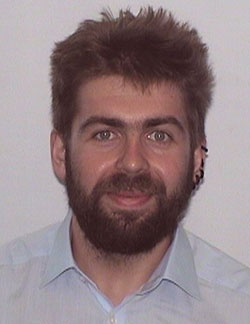
Department
School
Expertise
Biography
Dr. Greg Kalicy is an experimental physicist whose career is dedicated to advancing particle detector technology, specifically in the field of particle identification. He currently leads the development of the high-performance DIRC (hpDIRC) detector for the Electron-Ion Collider (EIC), a key component that enhances particle identification capabilities, pushing the boundaries of what is achievable in nuclear and particle physics research.
Dr. Kalicy earned his Master’s degree in Applied Physics from the Warsaw University of Technology, where his research focused on the Electromagnetic Calorimeter for the PANDA detector. He later received his Ph.D. in Physics from the Goethe University of Frankfurt, where he developed the PANDA Barrel DIRC detector at GSI, pioneering new methods in DIRC technology that have since influenced numerous particle physics experiments. His research portfolio includes vital contributions to several high-profile projects, including his work on the GlueX DIRC detector, advancing DIRC applications across different experiments.
In addition to his contributions to DIRC technology, Dr. Kalicy has also worked on the Heavy Photon Search (HPS) experiment, a significant venture in physics beyond the Standard Model that seeks to uncover new particles and interactions. His ongoing research interests span exotic hadron spectroscopy, where he investigates particles outside the conventional quark model and detector innovation for next-generation physics experiments.
As an educator and researcher, Dr. Kalicy is committed to advancing scientific understanding through cutting-edge research and mentoring emerging physicists. His work continues to expand the capabilities of particle detection technologies, offering new insights into the fundamental components and forces of the universe.
Research Interests
Dr. Greg Kalicy’s research interests focus on advancing particle detector technology and addressing fundamental questions in nuclear and particle physics. Central to his work is the development and optimization of DIRC (Detection of Internally Reflected Cherenkov light) detectors, especially the high-performance DIRC (hpDIRC) for the Electron-Ion Collider, which enhances particle identification in cutting-edge experiments. Dr. Kalicy is also engaged in exotic hadron spectroscopy, investigating hadronic states beyond conventional quark models, and in-depth studies of proton structure to uncover the complex internal dynamics of one of nature's fundamental particles. His research bridges detector innovation with probing the very building blocks of matter, pushing the boundaries of our understanding of particle interactions and the fundamental structure of the proton.
Current Projects
Dr. Greg Kalicy is currently leading several projects that leverage advanced DIRC (Detection of Internally Reflected Cherenkov light) technology for particle identification in high-energy physics experiments. A primary focus is his work on the high-performance DIRC (hpDIRC) for the ePIC detector at the Electron-Ion Collider (EIC), where he is advancing the detector’s capabilities to meet the rigorous demands of the EIC experiment. Additionally, Dr. Kalicy continues to work on the GlueX DIRC detector at Jefferson Lab. His research also extends into data analysis within GlueX, particularly focusing on hyperons—particles containing strange quarks. By analyzing hyperon production and decay, Dr. Kalicy seeks to deepen our understanding of strangeness in quantum chromodynamics (QCD) and the broader implications for hadronic matter. These projects collectively contribute to advancing particle identification technology and probing fundamental aspects of particle physics, with significant implications for nuclear physics and quantum field theory.
Selected Publications
“The high-performance DIRC for the ePIC detector at the EIC”, Nuclear Instruments and Methods in Physics Research Section A, Volume 1062, https://doi.org/10.1016/j.nima.2024.169168“Searching for Prompt and Long-Lived Dark Photons in Electro-Produced e+e- Pairs with the Heavy Photon Search Experiment at JLab”, Phys. Rev. D 108
“Initial performance of the GlueX DIRC detector”, Journal of Physics: Conference Series, Volume 2374
„Search for photoproduction of axionlike particles at GlueX“, Physical Review D, 105(5), 1-8, Article 052007
“Science Requirements and Detector Concepts for the Electron-Ion Collider: EIC Yellow Report”, Physical Review A, Volume: 1026, 2022, https://doi.org/10.1016/j.nuclphysa.2022.122447
“Installation and Commissioning of the GLUEX DIRC”, Journal of Instrumentation (JINST), 15 C09010
“The Barrel DIRC Detector for the PANDA Experiment at FAIR”, Springer Proc.Phys. 212 123-126, 2018, DOI: 10.1007/978-981-13-1313-4_25
“Technical Design Report for the PANDA Barrel DIRC Detector”, J. Phys. G: Nucl. Part. Phys. 46 045001
